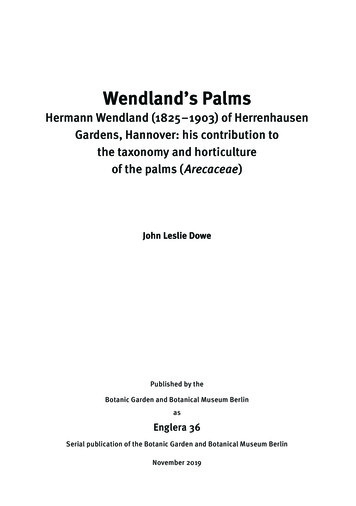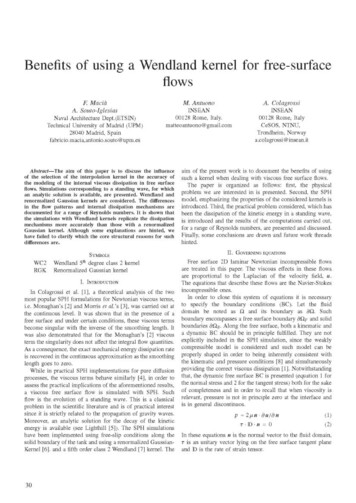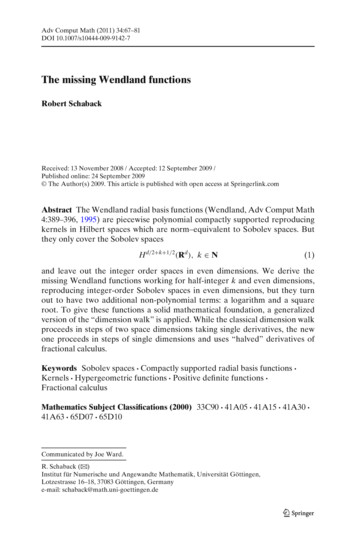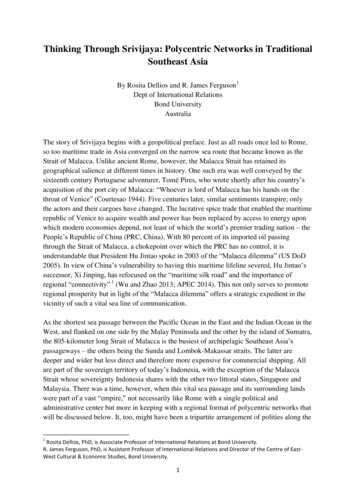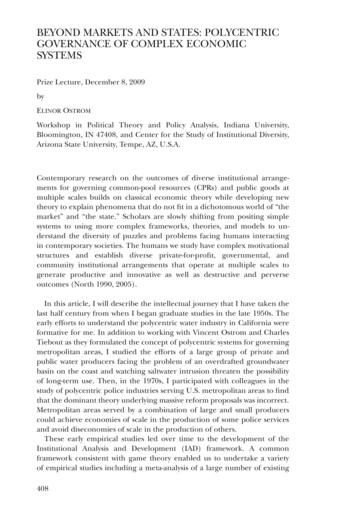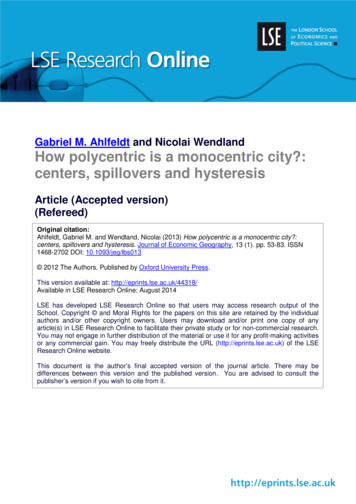
Transcription
Gabriel M. Ahlfeldt and Nicolai WendlandHow polycentric is a monocentric city?:centers, spillovers and hysteresisArticle (Accepted version)(Refereed)Original citation:Ahlfeldt, Gabriel M. and Wendland, Nicolai (2013) How polycentric is a monocentric city?:centers, spillovers and hysteresis. Journal of Economic Geography, 13 (1). pp. 53-83. ISSN1468-2702 DOI: 10.1093/jeg/lbs013 2012 The Authors. Published by Oxford University Press.This version available at: http://eprints.lse.ac.uk/44318/Available in LSE Research Online: August 2014LSE has developed LSE Research Online so that users may access research output of theSchool. Copyright and Moral Rights for the papers on this site are retained by the individualauthors and/or other copyright owners. Users may download and/or print one copy of anyarticle(s) in LSE Research Online to facilitate their private study or for non-commercial research.You may not engage in further distribution of the material or use it for any profit-making activitiesor any commercial gain. You may freely distribute the URL (http://eprints.lse.ac.uk) of the LSEResearch Online website.This document is the author’s final accepted version of the journal article. There may bedifferences between this version and the published version. You are advised to consult thepublisher’s version if you wish to cite from it.
How Polycentric is a Monocentric City?Centers, spillovers and hysteresis1Gabriel M. Ahlfeldta and Nicolai WendlandbaAddress for correspondence: London School of Economics and Political Sciences,Department of Geography and Environment & SERC,Houghton Street, London WC2A 2AE,phone [44] (0)20 78523785, fax [44] (0)20 7955 7412,g.ahlfeldt@lse.ac.uk, www.ahlfeldt.combDarmstadt University of Technology, Department of Law and Economics,Residenzschloss, Marktplatz 15, 64283 Darmstadt, Germanyphone [49] (0)6151 166506, fax [49] (0)6151 165652, wendland@vwl.tu-darmstadt.deAbstract: We assess the extent to which firms in an environment of decreasing transport costs and industrialtransformation value the benefits of proximity to a historic CBD and agglomeration economies in their locationdecisions. Taking a hybrid perspective of classical bid-rent theory and a world where clustering of economicactivity is driven by between-firm spillovers, Berlin, Germany, from 1890 to 1936 serves as a case in point.Our results suggest that the average productivity effect of a doubling of between- firm spillovers over the studyperiod increases from 3.5% to 8.3%. As the city transforms into a service-based economy, several microagglomerations emerge. Their locations close to the CBD still make the city look roughly monocentric. This isin line with a hysteresis effect in which second-nature geography drives the ongoing strength of a historic citycenter even though the importance of the originally relevant first-nature geography has vanished.Keywords:Transport Innovations, Land Values, Location Productivity, AgglomerationEconomies, Economic History, BerlinJEL classification:Version:N7, N9 R33, O121May 2012We thank the German Science Foundation (DFG) for funding large parts of this project. Wefurthermore thank Kristian Behrens (the editor), Stefan Goldbach, Christian Hilber, Volker Nitsch, andthree anonymous referees for valuable comments and discussions.
-2-1. IntroductionThe traditional models of urban economics view cities as aligned around a single,exogenously defined “mono”-center, the so-called central business district (CBD). Thevalue of urban land emerges from a trade-off of access and transport cost to this center(e.g. Alonso, 1964; Mills, 1969; Muth, 1969). More recent models, in contrast, haveacknowledged the polycentric structure of many cities in the world and attempted toexplain the emergence of more complex patterns through the interplay of various forcesof agglomeration and dispersion (e.g. Anas & Kim, 1996; Lucas & Rossi-Hansberg,2002). Monocentric and polycentric views on the spatial structure of cities, therefore,feature very distinct but potentially complementary underlying mechanisms thatgenerate economic densities.The traditional view of a firm‟s bid-rent function is that bid-rents have to diminish astransport costs to the exogenous center increase. The city center is often referred to as asort of market place where economic agents interact both with each other as well aswith government institutions and local authorities. An alternative or complementaryview is that of an export hub to which goods have to be shipped. It is, of course,questionable to which degree these characteristics apply to modern service-based(urban) economies. Alternative explications for the evident spatial clustering of firmshave instead built on the idea of scale-economies and spatial interactions that driveproductivity for firms in close proximity through various forms of spillovers and mutualaccess to (intermediate) inputs.A common approach in the literature for empirically testing the predictions of thetraditional (monocentric) models has been to look at the relationship between distanceto city centers and observed land values. Although in the historical context it has beensomewhat difficult to find appropriate data, the empirical literature has providedevidence for negative rent gradients, mostly for residential, but also for commercial land(McMillen, 1996). The magnitude of these gradients has been found to diminishconsiderably over time, a phenomenon that is widely interpreted as urbandecentralization. Based on these findings, however, it is hardly possible to drawconclusions on the origin of the spatial pull that drives firms into the center in the firstplace. Do firms discount their willingness to pay for land on the transport costs
-3-associated with shipping goods to the center or do they take advantage of locating closeto other businesses to enjoy a productivity externality, or both?Similarly, it is not entirely clear a priori whether rent gradients that diminish over timereflect a reduction in transport costs to the city center or the increase in agglomerationeconomies as the fundamental determinant of productivity of commercial land, and,hence, its market price. Clearly, if strong agglomeration economies are present, theyoffer the potential for increasingly larger sub-centers and edge-cities to emerge, whichwould reduce the magnitude of (negative) CBD gradients. A much cited example is LA,where sub-centers dominate the CBD so that even a positive gradient was found(Heikkila et al., 1989). Another potential outcome, however, are clusters of extremeeconomic density, e.g. lower Manhattan or the London Square Mile. Once a criticallevel of economic concentration has been established (e.g. if firms were attracted due tonatural advantages, a transport hub, or a government cluster), emerging spilloversbetween firms in such a cluster will reinforce densification through agglomerationbenefits. In such a scenario, the historically grown center will maintain its dominant role(reflected in a steep negative CBD gradient), even though the original (natural)advantage vanishes over time – a hysteresis effect.Against this background, we examine transport costs to the city center and the mutualattraction of economic activity as alternative and potentially complementarydeterminants for the value of commercial land. We chose Berlin, Germany, during thelate period of industrial revolution (1890-1936) as a case in point for three importantreasons. First, the city, in its development, resembles many European and NorthernAmerican cities during the Industrial Revolution. Berlin underwent a majortransformation in its industry structure towards a predominantly service-based economyand developed a dense network of intra-urban rapid transit. Both incidents should havestimulated spatial interactions among economic agents and, thus, the relevance ofagglomeration economies. Second, at the beginning of the study period, the cityexhibited an unusually high density of economic activity within the relatively smallurban core, which over centuries had established itself as the economic, political, andcultural center of Prussia. Third, even by the end of the study period, the city centerexerted a particularly strong attraction on firms – at a time when the typical evidence for
-4-U.S. cities suggests that the negative CBD gradients had almost disappeared (Ahlfeldt& Wendland, 2011). Together, these features make Berlin the perfect candidate for astudy on the abovementioned hysteresis effect as well as on more complex spatialphenomena underlying an apparently monocentric structure.To account for the fundamental change in accessibility due to the creation of a denseintra-city transport network, we model the effective travel time among each pair ofcommercial locations in the city for each observation year. In order to allow the spatialpull, which drives firms bid-rents, to originate from various locations and in order tomodel bidirectional spillovers, we make use of a gravity-type variable which had beenpreviously employed to explain the impact of labor market accessibility on residentialproperty prices (Adair, McGreal, Smyth, Cooper, & Ryley, 2000; Ahlfeldt, 2011;Osland & Thorsen, 2008), but has not yet been applied to commercial land. Unlikeprevious applications, we guide the empirical setup by means of a theoretical model thatlays the foundation for an interpretation of distance-weighted aggregated land value as ameasure of agglomeration benefits. With this approach we are able to distinguishbetween firm spillovers and CBD proximity effects in our empirical analysis.Our results indicate a flattening of the CBD gradient over time, which is in line withprevious evidence on historic land gradient evolution (Abelson, 1997; Atack & Margo,1998; McMillen, 1996; Smith, 2003).2 Even by the end of our observation period, westill observe a large and significantly negative CBD gradient, although there are notablesigns for the emergence of local micro-agglomerations within the broadly monocentricstructure. A closer look reveals a more fundamental change in city structure over thestudy period. While conditioning on agglomeration effects hardly affects the magnitudeof the gradient estimate in 1890, it is able to explain almost the entire variation in landvalues related to the distance-based CBD gradient roughly 50 years later. Overall, ourresults indicate that by the end of our study period the large and significantly negativeCBD gradient masked the presence of between-firm agglomeration economies. Weconclude that a differentiated view is required when interpreting monocentric gradientestimates. While at the beginning of our study period the city center acted as an2For a brief discussion on corresponding findings and data sets see Ahlfeldt & Wendland (2011).
-5-autonomous agglomeration force, in 1936 the negative gradient seems to reflect spatialinteractions among firms whose location had been pinned down by historic accident.2. Background2.1 Theoretical FrameworkThe uneven distribution of clusters of economic activity across the planet is a strikingregularity. The discussion of how and why economic densities emerge has for a longtime been dominated by the idea of two different forms of agglomeration economies.So-called first nature geography may be responsible for individual firms‟ initiallocation decisions (Berliant & Konishi, 2000; Ellison & Glaeser, 1999; Kim, 1995,1999). 3 Comparative advantages provided by certain locations create incentives forfirms and industries to cluster around focal points of interest. In many cases, thesemight have offered perfect conditions for cities and CBDs to emerge in the first place,e.g. if those locational advantages were represented by well accessible points such asports.Intense interactions between producers and consumers at the same location generateadditional benefits derived from second nature geography (Andersson, Burgess, &Lane, 2007; Berliant, Peng, & Wang, 2002; Fujita & Ogawa, 1982; Henderson, 1974,1977, 1988; Jacobs, 1969). An important factor for productivity gains derived fromspatial proximity to other firms consists in potential knowledge spillovers due to formaland informal communication (Ibrahim, Fallah, & Reilly, 2009; Mariotti, Piscitello, &Elia, 2010). Fujita and Ogawa (1982) construct a "locational potential function", wherefirms directly benefit from spatial proximity to other producers. They show howexternalities can account for different urban configurations ranging from simplemonocentric to polycentric outcomes. Notably, their model exclusively attributeslocation decisions to the existence of externalities. Similarly, Helsley (1990) relates hisresearch directly to the fact that agglomeration economies might be strongest within theCBD and are most likely to decline with distance. Compared to the view that goods andservices need to be transported to the city center, these models represent an oppositeextreme case, emphasizing second nature at the expense of first nature geography.3For a comprehensive overview of the nature of agglomeration economies see Rosenthal &Strange (2004)
-6-Our view of urban configurations is a hybrid of both perspectives, featuring elements ofclassic bid-rent theory where cities are aligned around an exogenous city core and anagglomerations literature that has emphasized externalities among firms as the drivingforce of spatial concentration. Our city consists of discrete city blocks indexed by i thatcan be used for commercial purposes. Urban land is scarce and provided inelastically.We assume a simplistic urban economy where identical firms produce a final goodunder perfect competition and constant returns to scale technology. The productiontechnology is Cobb-Douglas with outputat location i being a function of land area Land capital K, which is a composite of all non-land inputs(1)The productivity of the final goods production Aj depends on natural advantages, whichare reflected in (ai), and agglomeration forces. We distinguish between a predetermined(exogenous) center of spillovers named CBD in the spirit of classic rent theory(reflected in ) and a bidirectional, decentralized agglomeration force that depends onthe effective distribution of the surrounding mass as is conventional in the literature(reflected in ).(2)Productivity at block i increases in proximity to the CBD, where Di is a distancemeasure anddetermines the rate of decay in the proximity benefit. This will be thedominating agglomeration force in a world where all economic agents interact with eachother at the city center (e.g. a central market place or transport hub), and derive largebenefits from proximity to non-market actors who concentrate at that location (e.g.governments and authorities).(3)Productivity also depends on a bidirectional agglomeration force that increases in thesurrounding density of economic activity. There is a tradition in the urban literature tomodel these interactions as knowledge spillovers that depend on employment, which
-7-usually comes with the restrictive assumption of homogenous workers. 4 Instead, weassume a broader agglomeration economy encompassing urbanization, localization andcoagglomeration effects. This black-box agglomeration force directly emerges from thesurrounding economic mass, thus incorporating the productivity of all non-land inputs,and corresponds to total output at surrounding blocks j weighted by bilateral distancesdij. (4)While parameterdetermines the relative importance of this agglomeration forcefor productivity,parameterizes the rate of spatial decay of spillovers in distance.Natural advantages and complementary or undesirable land uses (s) further shift theproductivity at a given block i depending on their distance (ds) and the spatial decay inthe spillover that is determined by parameters .(5)Firms maximize profits by choosing capital and land use while taking factor prices,productivity and the location choice of other firms as given. The price of land is bid-rent, while the price of capital is chosen as the numeraire. First order conditions definethe marginal rate of substitution among input factors as a function of relative factorprices.(6)With competitive markets, free entry and exit and, hence, zero profits, this condition canbe used to determine the equilibrium condition for bid-rents at location i. In keepingwith intuition, higher productivity makes a block more attractive, leading to higherequilibrium bid-rents.(7)4Lucas & Rossi-Hansberg (2002) for a recent example. See also Alonso 1964, Fijuta andOgawa 1982, Lucas 2000, Muth 1969, Mills 1969 and Sveikauskas 1975.
-8-To determine the spatial equilibrium we can make further use of the zero-profitcondition that must also hold at all other locations j in the city. Output at location j canbe expressed as a function of the occupied land area and the local equilibrium rent.(8)Substituting (2), (3), (4), (5) and (8) into (7) and taking logs lays the foundations for aregression-based empirical test of the spatial equilibrium condition. (9)From the spatial equilibrium condition (9), some general implications regarding the citystructure and its driving forces emerge. Land rents increase in access to economicactivity and decrease in distance to the predefined historical center and locationalamenities. The magnitudes of the marginal effects of all these location features increasein the share parameter of non-land inputs, which determines the rate of substitutionbetween land and capital. This is particularly the case for the bidirectional decentralizedagglomeration force, which is the intuitive result of surrounding firms substituting landfor capital as the densities and agglomeration benefits increase.Some simple comparative statics exercises also yield intuitive implications.Bidirectional agglomeration forces ( should exhibit an increasing impacton the spatial equilibrium structure of the city over time. For one thing, we expect theimportance of agglomeration economies (β) in itself to increase over time due to thetransformation into a service-based economy. For another thing, the share of non-landinputs (α) should certainly not decrease, as over time production and constructiontechnologies, if changing at all, would improve. For the effect of proximity to the CBD( ) the implications are less clear. The effect of an increase in the share of non-landfactors could work into the opposite direction of a decline in the importance of thehistorically predetermined center as an agglomeration force. If, however, a decline inthe net-effect can be observed empirically, this will be indicative of the residualagglomeration force subsumed under distance to the CBD losing strength.
-9-2.2 Berlin 1881-1936Our study period covers the second phase of industrialization in Berlin. As is typical forthis stage of development, the period was characterized by rapid population growth andtechnological innovations. This era is of particular interest for the purposes of thisarticle for a number of reasons.First, anecdotal evidence suggests that a traditional monocentric city structure began tobreak up and new, specialized sub-centers started to attract commercial activity by thebeginning of the 20th century (Krause, 1958). However, these new business locations,namely plazas such as Potsdamer Platz and Alexanderplatz, were still located in closeproximity to the very center of the CBD. This is directly related to one of theoutstanding features of historical Berlin‟s inner city. The area of the CBD wascharacterized by an unusually dense concentration of quarter-like segregated businessareas, where each function was represented by a highly specialized area. 5 Thesedensities created opportunities for physical interactions and, therefore, potentialagglomeration benefits. While these were located within relative proximity around thevery center, new business agglomerations also emerged even at relatively remotelocations.6 The area around the Kurfürstendamm is probably one of the most prominentexamples. After rising to become a major entertainment and luxury retail center in the1920s, it grew to be the CBD of West-Berlin during the years of division and hasmaintained its status until today.Second, this development was accompanied by the transformation from a craftsmandominated economy into a service-based one (Bergmann, 1973). Holding the status ofcapital for both Prussia and the German Reich since the end of the French-Prussian Warin 1871, this new prestige and various administrative and political entities drew firmsand service-oriented industries such as banks and the media into the city. Table 1 showshow the industry structure of the city changed sustainably over our observation period.5Within the CBD, located at close proximity one could find the “Banking District” (Bankenviertel), the“Government District” (Regierungsviertel), the “News District” (Zeitungsviertel), the “ClothingDistrict” (Konfektionsviertel), the “Export District” (Exportviertel), and the “Insurance District”(Versicherungsviertel).6Alexanderplatz is located approximately 770 meters to the northeast of the historical City Palace(Stadtschloss) and PotsdamerPlatz lies about 2km to the southwest. We define the CBD as the metrostation "Stadtmitte" (Downtown).
- 10 -In 1890, the manufacturing sector with a share at total employment of 42.22 percent,clearly dominated trade and services (19.93 percent). Within the boundaries of theCBD, only 13.35 percent of the workforce was employed in sectors of trade andservices, whereas the corresponding number for the manufacturing sector was abouttwice the size. This relationship was completely reversed by 1933. The total shareswithin the boundaries of Old-Berlin changed considerably to 35.8 percent formanufacturing and 43.01 percent for trade and services.7 Especially after 1900, almostall large manufacturing firms had moved towards remote districts such that this changewas even more fundamental for the CBD (the district of Berlin-Mitte). In this area, tradeand services dominated manufacturing by a factor of two (65.67 vs. 34.4 percent). TheCBD was mainly characterized by the unusually large work force within its finance andinsurance industries as well as in retail and wholesale trade with more than 120.000employees.Tab. 1AreaYearTotal:1890193318901933CBD:Industry Employment in 1890 and 1933 (Old-Berlin Boundaries)ManufacturingEmploymentEmployment 34.30%Trade and ServicesEmploymentEmployment 65.67%Notes: Figures are taken from the industry census of Berlin for 1890 and 1936, respectively. The1936 edition provides data based on the 1933 census. We use a 1936 spatial definition of theCBD in both years. Manufacturing numbers also include mining and construction, whereastrade and services include trade, transportation, communication and utilities, business servicesand FIRE industries. Domestic services (private Dienstleistungen) are excluded.Third, a dense network of intra-urban transport emerged. In 1877, the circular line,which connected Berlin to its surroundings and to several regional lines, wasinaugurated. Then, in 1882, an east-west connection joined several inner-city stationswith the circular line (Borchert, Starck, Götz, & Müller, 1987). This, however, was onlya first step in generating inner-city travel systems and it was not for several decades that7We strictly refer to numbers within the outer city-boundaries of 1890 to ensure feasible comparison. In1920, in the grand amalgamation, Old-Berlin had been joined with seven other cities, 59 ruralmunicipalities (Landgemeinden), and 27 rural districts (Gutsbezirke).
- 11 -gradually added stations created a highly developed and very dense network thatfundamentally changed the pattern of urban accessibility.8A number of additional events taking place during our study period are worthmentioning. First, an ambitious planning agenda, the so-called Hobrecht Plan, waspursued by local authorities, which in many respects followed the famous ParisienHaussman Plan. It is important to note, however, that the allocation of economicactivity within that area was not explicitly influenced by zoning policies (Richter,1987), except for a general ban on buildings that exceeded a height of 24m, the socalled “Traufhöhe”. Second, some remarks must, of course, be directed towards WWIand the Great Depression. The depressing effects on the urban economy are clearlyvisible in our data for 1929, and to a smaller degree also for 1936. However, theepicenter of the fighting was far away and the city did not suffer major war damage thatwould have potentially caused major spatial reorganizations. While the entire GermanReich was affected by reparations, historic sources provide little evidence for anynotable impact on the spatial structure of Berlin. Movements of heavy industry towardsremote districts had taken place mostly during the years before WWI. Throughout thestudy period, the CBD maintained its position as the main center for governmentactivity, media and FIRE industries, which recovered quickly from WWI and the GreatDepression. Some historians even argue that the effects of WWI strengthened Berlin‟seconomic position and fostered its industrial growth (Erbe, 1987). Finally, our studyperiod ends before Hitler imposed a general price stop by the end of 1936 to prevent afurther inflation that would have been the natural consequence of an economicdownturn and increased government spending.8Car usage was, in general, only affordable to high-income families and very few firms resulting in arelative small number of about 77.000 privately used cars and about 28.000 commercially used trucks in1936, which shows the small impact on general accessibility patterns across the city (Statistical Yearbookof Berlin, 1936).
- 12 -3. Empirical Analysis3.1 DataIn the selection of the sample area studied we faced a trade-off between a) keeping thesample to a balanced panel of the same plots throughout all years to prevent thatestimated spatial decays are driven by changes in the overall size of the study area orchanges in the composition of blocks within the study area and b) selecting plotsprimarily occupied by commercial activity that reflect the determinants of firm bid-rents(McMillen, 1996). We choose commercial plots based on a historical land value mapdrawn up by Bruno Aust (1986), which shows real land uses at the individual plot levelfor a large part of Berlin in 1940. Since, in principle, land use at a given location couldchange over time this selection implies that some locations temporarily used forcommercial purposes could be missing in our sample while some of our plots couldhave been used for residential purposes temporarily. It is notable, however, that a largedegree of persistency in spatial land use pattern has been a particular feature of Berlin.Commercial activity has mainly taken place along a grid of radial and circularboulevards created by the major urban redevelopments during the 19th century in theaftermath or the Hobrecht-Plan (resolved in 1862). Up until the late 20th century,differences in (persistent) building stock served as a natural determinant of land usesegregation. For the balanced panel of 1470 plots where land values were continuouslyavailable from 1890 to 1936, we expect that these were the typical locations wherecommercial activity took place and that commercial use was mostly the dominantdeterminant of the local bid-rent throughout the observation period.For these 1470 plots, we collect land values from historic maps (Müller, 1890-1910)and street indices (Kalweit, 1928, 1936) that refer to market prices of pure land,adjusted for building, soil, and garden characteristics. The resulting area covers an areaof approx. 9 kilometer radius around the present-day subway station “Stadtmitte”(Downtown), which serves as a feasible proxy for the city center throughout the studyperiod. A more detailed description of the land value data and the collection process isprovided in the data appendix (A) and by Ahlfeldt and Wendland (2011).
- 13 -A number of spatial variables were calculated using GIS. Among them, straight-linedistances to the next major park or forest area and nearest body of water, which aretime-invariant. Further, we calculate straight-line distances to the next industrial areabased on available historical maps that fit the respective years as closely as possible.9Table 2 provides descriptive statistics for the discussed data. Bilateral travel times arediscussed in the next subsection. Land values (NLV) in Table 2 (and the rest of thepaper) are adjusted to 2005 values for ease of comparability. Note that the maximumvalues in each year are relatively close to the 2005 maximum (20,000 /m²).10Tab. 2Descriptive statisticsNLV 1890NLV 1900NLV 1910NLV 1929NLV 1936Distance to the CBDTravel time to CBD 1890Travel time to CBD 1900Travel time to CBD 1905Travel time to CBD 1910Travel time to CBD 1936Agglomeration Pot. 1890Agglomeration Pot. 1900Agglomeration Pot. 1910Agglomeration Pot. 1929Agglomeration Pot. 1936Distance to industry 1880Distance to industry 1910Distance to industry 1940Distance to waterDistance to green spacesObs.MinMaxMeanMedian1470 32.26 19,892.47 1,908.68 1,075.271470 111.11 22,555.55 3,293.97 2,216.671470 175.93 20,833.33 4,045.66 2,916.671470 16.85 22,471.91 1,420.95 674.161470 20.83 17,361.11 1,581,05 775.4614700.068.163.203.211470 0.50869.31633.48934.4751470 0.50861.01732.73533.0671470 0.50859.31127.67226.4701470 0.50844.22118.43418.2361470 0.50844.22118.40218.1861470 0.207738.46180.40226.4431470 0.421912.541 133.91554.3851470 0.667 1033.790 168.92382.7001470 0.064491.35473.26034.2381470 0.080557.67580.62738.2841470 0.0012.020.330.221470 0.0011.140.260.201470 0.0011.350.330.241470 45
and Nicolai Wendland. b a. Address for correspondence: London School of Economics and Political Sciences, . phone [44] (0)20 78523785, fax [44] (0)20 7955 7412, g.ahlfeldt@lse.ac.uk, www.ahlfeldt.com . b. Darmstadt University of Technology, Department of Law and Economics, Residenzschloss, Marktplatz 15, 64283 Darmstadt, Germany
